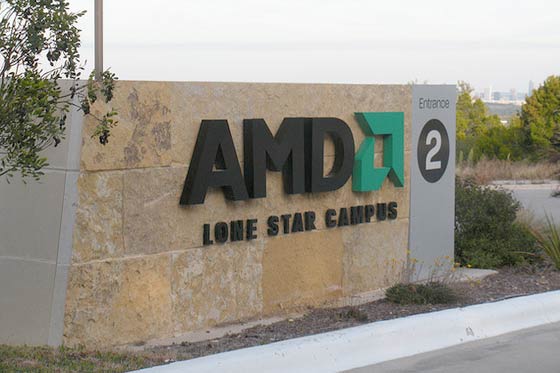When Advanced Micro Devices, or AMD for short, was created in 1969, it adopted an arrow logo, and the firm has used essentially the same logo since then. The original AMD logo included two arrowheads, one huge and one small. You can also think of the arrowheads as two right angles that point in different directions.
The AMD logo’s arrow symbol appears after the company’s nameplate and points upwards to the right, symbolizing the company’s movement and advancement. But how did they come up with this logo? And how has it evolved over the years?
Well, let’s find out.
What Exactly is AMD?
AMD is the brand name of a computer processor manufacturer founded in the United States in 1969. The company’s name stands for Advanced Micro Devices, which properly describes the company’s sphere of commercial activity. AMD has a global presence.
History and Meaning (AMD Logo)
AMD is one of the most important companies in the world that makes central processing units and graphics processors. It started at the end of the 1960s. AMD stands for “Advanced Micro Devices.” It was started by eight people who worked at Fairchild Semiconductor, which at the time was one of the most powerful companies that made semiconductors.
Robert Noyce, the head of Intel at the time, was one of AMD’s earliest investors.
The majority of the funds were raised by private investors from Capital Group Companies.
The first product, the Am9300 4-bit register chip, was unveiled in November 1969.
The first Am2501 binary/hexadecimal logic counter, created entirely in-house, was presented in 1970.
AMD has closely monitored the quality of its products since its founding, and in 1976 became the only integrated circuit business to be approved for military and space class quality.
In subsequent years, AMD largely manufactured microprocessors under license from Intel, albeit with its own enhancements.
1969 – 1980
The company’s visual brand identity has remained quite stable. Even though the first AMD logo came out more than 50 years ago, parts of it are still in the current one.
The original emblem was made up of two arrowheads, one small and one huge. They are also known as two square angles. They were pointing in different directions. On the white background, the arrowheads were solid black.
1980 – 1990
For over a decade, the company used a slightly modified version. The arrows in this case were white with a prominent black outline, rather than solid black. The arrows in the former logo were also slightly bolder.
1995 – Today
AMD is an acronym for Advanced Micro Devices, and its logo consists of an all-caps wordmark and an emblem.
The typography of the wordmark is clean and rigid, with geometrically perfect lines. The letters are well-balanced and appear to be confident and masculine.
The AMD logo is an Arrow made up of two smaller arrows. The AMD Arrow appears after the nameplate and points upwards and to the right, representing movement and advancement.
The logo’s monochrome tone emphasizes the brand’s stability and authority, as well as shows consumers that the company can be trusted.
The AMD logo is simple and modern. It has a unique style that emphasizes the harmony of lines and the perfection of design. The logo conveys confidence and authority, as well as respect and knowledge.
Elements of AMD Logo Design
Color:
The AMD logo is made up of two parts: text and a graphic. The simple version has two polygonal arrowheads with the acronym “AMD” in all-black. There’s also a less common variant of the AMD logo that incorporates jungle green geometric designs.
Font:
The AMD wordmark solely employs uppercase letters. The letters are written in a rigorous sans-serif style. While the letters “M” and “A” are straight, the letter “D” is rounded and streamlined.
In addition to being useful and serious, the arrowhead logo shows that customers have full faith in AMD products. It also conveys practicality and purposefulness, as well as provides clients with a sense of security.
Is AMD good for gaming?
The third-generation Ryzen central processing units (CPUs) manufactured by AMD are among the very best processors that have ever been created. These CPUs provide outstanding performance while a single thread is being executed, and even more impressive multithreading capabilities. Because of this, not only are they ideal for productivity tasks like video editing and transcoding, but they are also outstanding for gaming.
Is AMD faster than Nvidia?
The top video cards that AMD has to offer, such as the Radeon RX 6950 XT, RX 6900 XT, and RX 6800XT, provide ray tracing performance that is more comparable to that of Nvidia’s less expensive RTX 3070 and RTX 3070 Ti graphics cards. When ray tracing is turned on, the most powerful video cards available from Nvidia are up to 50 percent faster than those from AMD.
AMD’s Evolution
AMD (Advanced Micro Devices) is a multinational semiconductor company based in the United States that develops computer processors and related technologies for both personal and commercial usage. While the business initially manufactured its own processors, in 2009 it outsourced that task to its spin-off GlobalFoundries.
AMD’s most important products for PCs, workstations, embedded systems, and servers are microprocessors, embedded processors, graphics processors, motherboard chipsets, and field-programmable gate arrays (FPGAs).
Historical Background
In May 1969, Jerry Sanders and seven of his former coworkers at Fairchild Semiconductor started Advanced Micro Devices. Sanders, an electrical engineer, was Fairchild’s marketing director. He and many other ex-Fairchild executives had grown tired of the firm’s absolute lack of opportunity, flexibility, and support.
He eventually decided to leave and start his own semiconductor company, just like Gordon Moore (with whom he co-founded Intel in 1968) and Robert Noyce (who made Fairchild’s first silicon integrated circuit in 1959).
AMD’s temporary headquarters were in Santa Clara, California. The company relocated its headquarters to Sunnyvale, California, in September 1969. Initially, the company was a franchise seller of National Semiconductor and Fairchild Semiconductor microchips.
AMD initially concentrated on logic chip development. US Military Standards were in charge of quality control, which was a big plus in the young computer business at the time because microchip instability was a unique problem that customers always tried to avoid.
Read Also: WINDOWS LOGO: Concept, Symbol, History, and All You Need to Know
The Am9300, a four-bit MSI shift register, was AMD’s first product, released in November 1969 and sold the following year. In the same year, the business created its first product, a logic counter known as the Am2505, which became the fastest multiplier on the market.
AMD made its initial attempt in the RAM chip sector in 1971, with the Am3101, a 64-bit bipolar RAM. The sale of AMD’s linear integrated circuits also surged dramatically that year. By the end of 1971, the company’s total annual sales had reached $4.6 million.
AMD went public in September 1972. By 1973, the company was making MOS/LSI circuits for Intel, like the Am14/1507 and Am14/1506, which are two 100-bit shift registers. By 1975, AMD was producing 212 different products, 49 of which were proprietary.
Intel produced the first microprocessor, the 4-bit 4004, in 1971. By 1975, AMD had dipped its toe into the microprocessor sector with the Am9080. The Am9080 was a reverse-engineered version of the Am2900 bit-slice microprocessor family and Intel 8080.
In 1977, AMD joined forces with the German engineering company Siemens to help Siemens break into the US market and learn more about technology. Siemens purchased a 20% stake in AMD, providing the latter the funding to develop its product lines.
Read Also: COKE LOGO: Meaning, What Changed, and How Much It Is Worth
Advanced Micro Computers was made by AMD and Siemens working together. It has offices in both Germany and Silicon Valley. This enabled AMD to enter the microcomputer manufacturing and development market, based on AMD’s Zilog Z8000 microprocessors.
The two firms, however, had opposing ideas for the newly founded Advanced Micro Computers. As a result, in 1979, AMD purchased Siemens’ stake in the US division. After making Intel x86 microprocessors for a while, AMD shut down Advanced Micro Computers at the end of 1981.
AMD’s total revenues surpassed $100 million in the fiscal year 1978. AMD was first listed on the New York Stock Exchange in 1979. That same year, work began on the company’s brand-new Semiconductor design plant in Austin, Texas.
AMD had already established manufacturing operations in Manila and Penang, Malaysia, and had begun construction on a design facility in San Antonio, Texas, in 1981. A year ago, AMD started selling semiconductors to the telecommunications market. Since then, the company has seen a lot of innovation and growth.
In the 1980s
Personal computing entered the mainstream in the early 1980s, and AMD began to assist the exponential expansion with excellent alternatives to Intel x86 microprocessors. AMD expanded its design operations to fulfill customer demand and invested heavily in research and development. Furthermore, the corporation introduced the highest manufacturing standard of the time, INTT.STD.1000.
By the end of the 1980s, the company had started building its own Submicron Development Center, which is where it would work on improving process technology over the next ten years. The company’s manufacturing costs have gone down because of these breakthroughs, which have an effect on all stages of production. The company can now offer its clients exciting new technologies before its competitors can.
The 1990s
AMD’s marketing strategy shifted in the early 1990s. To provide more diverse solutions to its customers, the firm expanded its influence into sectors such as high-performance logic devices, programmable logic devices, PC-compatible microprocessors, and high-performance memory, communication, and networking chips.
After a protracted legal battle, AMD broke Intel’s x386 microprocessor monopoly and supplied over 1 million units of its own Am386 processor series. In 1993, the company began shipping Am486, its next-generation microprocessors, providing clients with even more opportunities for cost reductions and innovation.
Throughout the 1990s, AMD remained at the forefront of integrated circuit manufacturing, ranking high in all of its primary business categories. It also continued to innovate, developing a new 32-megabit 1.8-volt memory device in 2000, allowing mobile phone manufacturers to deliver cutting-edge features such as electronic organizers and global positioning systems.
The 2000s
In the year 2000, Dr. Hector Ruiz was named the company’s new Chief Operating Officer and President.
As the fortunes of the IT industry plummeted and the economy stalled, his knowledge and experience in processor technology and elite customer- and business-focused enterprises put the company in a solid position. Actually, AMD outperformed the rest of the industry.
In 2002, Ruiz proposed a new corporate philosophy known as the “connected business model,” in which customers, partners, and organizations would form ties and invest in one another. AMD established a development facility to put the new strategy into action.
AMD took another significant step forward in 2003. It was the first company to find a way to change the x86 architecture, which is the industry standard, to 64-bit personal and business computing. The company’s Opteron CPU made 64-bit computing easier for customers and improved performance, which led to a long-term partnership with Sun Microsystems.
The Athlon 64 processor from AMD is the best on the market because it uses technology that works with both 32-bit and 64-bit computing. Dick Meyer, who used to be President and Chief Operating Officer of AMD, and Fred Weber, who used to be Chief Technology Officer, both played important roles in the development of AMD’s groundbreaking 64-bit technology.
ATI and Xilinx Acquisitions
AMD paid over $5.4 billion for ATI Technologies, a Canadian 3D graphics card company, and 58 million of its shares in July 2006. Three months later, the transaction was completed. The business announced the rebranding of its ATI graphics chipsets to AMD at the end of August 2010.
AMD started GlobalFoundries Inc. as a result of a joint venture with the Advanced Technology Investment Corporation, which is part of the Abu Dhabi government. This venture was worth billions of dollars. AMD received a cash inflow as a result of the spin-off and cooperation, allowing it to focus completely on-chip creation.
AMD took several precautions to reassure its Abu Dhabi funders that the new company would be successful. To begin, AMD CEO Hector Ruiz left in July 2008 but remained executive chairman before becoming GlobalFoundries chairman in March 2009.
Dirk Meyer, AMD’s Chief Operating Officer and President, was named CEO. The same year, due to recessionary losses, 1,100 AMD employees were laid off.
Read Also: BEST BUY LOGO: Why is the Best Buy Logo Yellow? The Success Story!
AMD was divided into two groups in October 2014: enterprise, embedded, semi-custom, and computing and graphics. The former is mostly made up of embedded and server processors, engineering services, dense servers, royalties, and semi-custom SoC products. On the other hand, the second group is mostly made up of processors, chipsets, professional graphics, and discrete GPUs for notebooks and desktops.
Following the GlobalFoundries investment and subsequent layoffs, AMD was left with a large amount of unoccupied space at its aging Sunnyvale headquarters. After 47 years in Sunnyvale, California, AMD moved its main office to Santa Clara, California, in 2016. The company’s new headquarters are direct across the street from Intel’s headquarters.
In addition, when the firm relocated to Santa Clara, AMD decided to sell its previous offices to the Irvine Company. The Irvine Company’s plan to tear down its new headquarters and turn the entire 32-acre site into apartments and townhomes was approved by the Sunnyvale City Council.
AMD announced in October 2020 that it would acquire Xilinx in a stock-only transaction. The transaction was completed in February 2022 for about $50 billion.
After more than 50 years in the business, AMD keeps coming up with new ideas and making progress in the digital age. However, the corporation does not simply improve technology for the sake of improvement. It wants to help its clients all over the world find solutions to real-world problems in the 21st century and beyond.
In Conclusion,
Advanced Micro Devices, or AMD, is a business based in the United States that specializes in the development of computer processors, motherboard chipsets, and microprocessors. AMD also creates graphic processors, which are used in a variety of computer systems such as personal and corporate computers, game consoles, and portable devices.
Edwin Turney and Jerry Sanders founded the company in 1969, and it is headquartered in Sunnyvale, California. It has now grown to become the world’s second-largest maker of microprocessors and the third-largest manufacturer of graphics processing units.
AMD combined with ATI Technologies in 2006, combining the CPU provider and the first business to manufacture a 3D graphics chip. ATI was the first manufacturer to release products that supported the Accelerated Graphics Port. ATI had supplied 10 million AGP chips by 1998.
AMD’s major priority has always been to create new, creative products that actually benefit its customers. The company has always catered to the needs of its customers, and it is constantly developing new technology that improves over time.
Related Articles
- INTEL LOGO: Meaning, Driver, Careers and History
- Best 13+ CREDIT CARD SYSTEMS FOR SMALL BUSINESS 2023
- Best 10+ CREDIT CARD PROCESSING FOR SMALL BUSINESS NO MONTHLY FEE
- Micro Loans: Guide To Help You Make Informed Decisions (+ All You Need)






